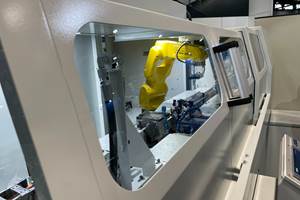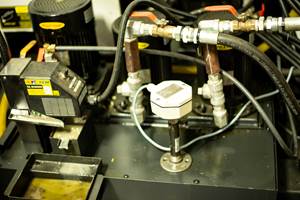Ozone Provides Solution To Bacteria In Coolants
Bacterial growth in metalworking fluids eventually leads to machine downtime. Furthermore, shop owners and plant managers see an increased cost of purchasing replacement fluids and the disposal of spent fluids.
The problems associated with coolants are well known in metalworking plants. Every machine tool operator has horror stories about foul odors and tramp oil in sumps. In addition, skin rashes can be a problem among machinists. Bacterial growth in metalworking fluids eventually leads to machine downtime. Furthermore, shop owners and plant managers see an increased cost of purchasing replacement fluids and the disposal of spent fluids.
Many times, shops will attempt to "fix" the problem with chemical additives. This results in a temporary solution. Additives are expensive and greatly reduce the life of the coolant. The same problems will recur in a short time. Adding chemicals can be compared to painting over rusted metal.
Portable reconditioning systems use a combination of old and new technology to provide real solutions to coolant concerns. There are several manufacturers of reconditioning systems that remove tramp oil, coalesce it, skim it and place it in a tramp oil container for disposal. These systems sometimes utilize a filtration system to remove suspended solids from the coolant. However, there are other options that take approach coolant management quite differently.
One of these new coolant management tools is being provided by Coolant Wizard, Inc. (Indianapolis, Indiana). According to company president, Bill Bettag, ozone generation is an efficient and effective way to control and reduce bacteria and fungus growth without purchasing chemical additives.
When ozone is used on portable reconditioning systems it is most commonly generated by an ultraviolet light. Ozone molecules are made up of three oxygen atoms. While ozone is bubbled into metalworking fluids, the third oxygen atom that makes up ozone "attacks" bacteria, fungus, yeasts and molds and oxidizes them. What is left is plain oxygen.
In 1992, work was started to carefully examine the effects of ozone generation on metalworking fluids. Tests were first done in field workshop environments. The results, Mr. Bettag reports, were dramatic. Coolant lasted longer, odors were no longer a problem, and skin irritation from coolant contact went away. The testing was expanded to shops where fungus growth was clogging coolant lines and causing slime to form in the sumps. Again, ozone worked effectively at alleviating these situations. Literally overnight, improvements were noticed by machine operators and by in-house environmental managers, he says.
In an effort to provide scientific documentation of ozone generation on metalworking fluids, testing was then taken to an independent laboratory to identify any possible negative effects of using ozone to control bacteria growth in coolant. In addition, the laboratory closely examined any possible health effects the ozone might have on machine tool operators. According to Mr. Bettag, the outcome was as impressive as the results from the field tests.
Apparently, ozone has no negative effects on machined parts. Special attention was paid to residual ozone possibly oxidizing equipment and finished metal parts. It was found that no residual ozone was left in the coolant to harm machine tools and parts because it is consumed in the process of killing organisms in the fluid. As to the question of ozone off gas being inhaled by shop personnel, laboratory research confirms that no off gas is present more than 6 to 8 inches from the sump because the off gas is used to kill bacteria in the fluid. In addition, ozone was found to have no negative effects on the coolant itself in terms of quality and effectiveness.
While many portable reconditioning systems use a simple concept of skimming and filtration, these procedures do not control bacterial growth, Mr. Bettag says. "Ozone is the answer," he claims.
The metalworking industry will continue to look at reconditioning systems as the purchase costs of replacement coolant concentrates, shipping charges, regulatory paperwork and disposal costs continue to climb. Mr. Bettag recommends that, when researching a reconditioning system that can help manage metalworking fluids in a shop, buyers should be sure to ask about what method is used to eliminate bacteria and fungus.
Related Content
IMTS 2022 Review: Attention to Automation Extends Beyond the Robot and the Machine
The advance toward increasingly automated machining can be seen in the ways tooling, workholding, gaging and integration all support unattended production. This is the area of innovation I found most compelling at the recent International Manufacturing Technology Show.
Read MoreManaging Coolant with Skimmers, Refractometers and More
Bacteria-infected coolant harms machines and sickens machinists. Coolant management technologies like skimmers and automated systems counter this tendency.
Read MoreUnist's Electronic Control Regulates Lubricant Delivery
Unist’s Pulse R electronic control ties into the system control solenoid valve and takes the place of a pneumatic pulse generator timer or logic block.
Read MoreJorgensen's Coolant Collection System Eliminates Sludge Build-Up
The PermaClean system adds agitation to the coolant collection system or holding tank and prevents particulates from settling.
Read MoreRead Next
The Cut Scene: The Finer Details of Large-Format Machining
Small details and features can have an outsized impact on large parts, such as Barbco’s collapsible utility drill head.
Read More3 Mistakes That Cause CNC Programs to Fail
Despite enhancements to manufacturing technology, there are still issues today that can cause programs to fail. These failures can cause lost time, scrapped parts, damaged machines and even injured operators.
Read More

























